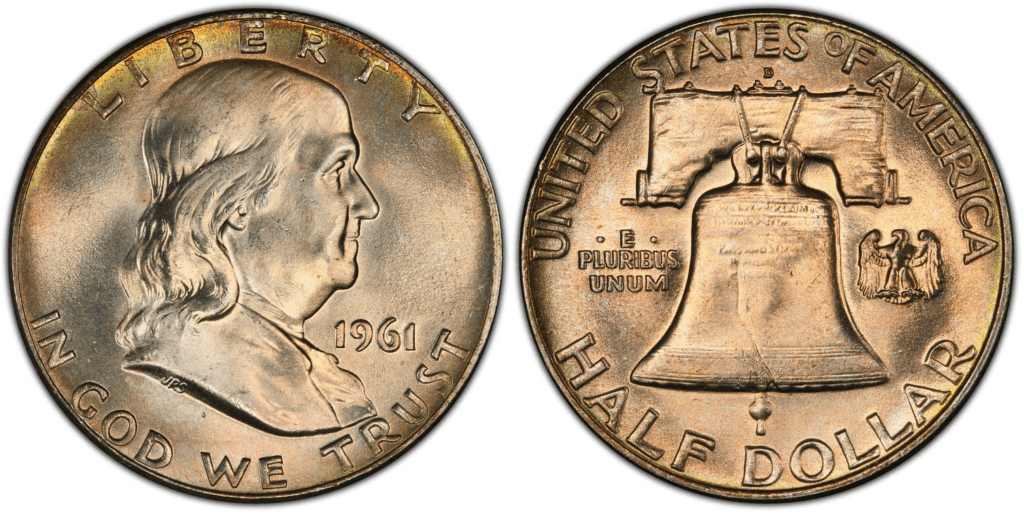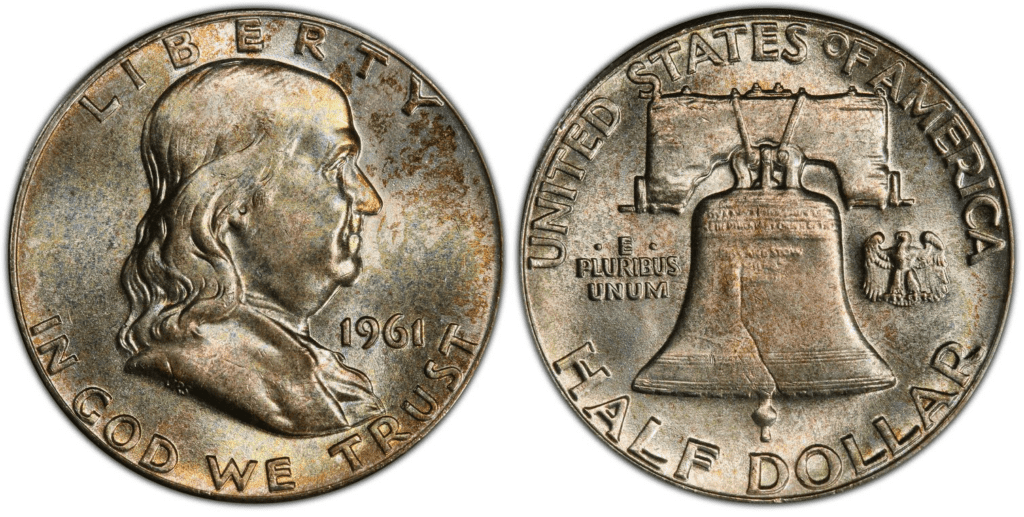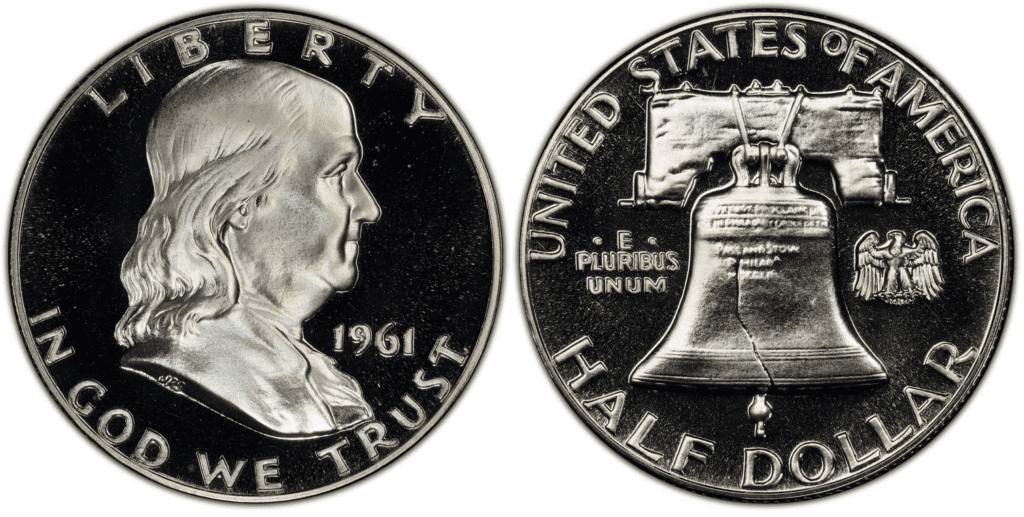What Is the 1961 Franklin Half Dollar Made Of?
The 1961 Franklin half-dollar is made of 10% copper and 90% silver. Its silver content is equivalent to 0.36169 troy oz. From 1948, the first year the Franklin half dollar was issued, to 1963, the half dollar was primarily made of silver.
The 1961 Franklin half dollar has a face value of $0.50. The mass of this silver coin is 12.50 grams. Its thickness is 1.8 mm, while its diameter is 30.61 mm. It has a reeded edge.
The first Franklin 50-cent coin was issued in 1948. Before that, the 50-cent coin features the Walking Liberty design. The US Mint struck this coin in Denver and Philadelphia.

photo source: USA Coin Book
Regarding the design, the obverse features a bust of Benjamin Franklin. He is one of the Founding Fathers of the United States. Inscriptions on the obverse include LIBERTY, IN GOD WE TRUST, AND 1961.
On the reverse, you’ll find the Liberty Bell. Aside from that, a small eagle was included to fulfill the legal requirement that all half-dollar coins should include a picture of an eagle. Inscriptions include UNITED STATES OF AMERICA, E PLURIBUS UNUM, and HALF DOLLAR.
In just a few years later, in 1964, the Franklin half-dollar would be replaced by the Kennedy half-dollar.
The 1961 Franklin half dollar has at least three varieties, which include a proof version. The US Mint that produced the 1961 half-dollar coin were Denver and Philadelphia. If you look at the coin varieties, there are no big differences except for their mint mark. However, proof coins are known to be more detailed, attractive, and shinier in appearance.
1961 half-dollar error coins also exist, giving rise to new varieties.
Here are the 1961 Franklin half-dollar varieties that you should know:
1961 D Franklin Half Dollar
Year of minting: 1961
Mint Mark: D
Place of minting: Denver
Quantity produced: 20,276,442
Face Value: $0.50 (one cent)
Price: $0.50 to $15.00 (or more)
Mass: 12.50 grams
Edge: Reeded
Designer: John Sinnock (with the help of Gilroy Roberts)
Composition: 90% silver and 10% copper
Diameter: 30.00 mm
Thickness: 1.8 mm

photo source: PCGS
The 1961 D half dollar was produced in the Denver Mint. Thus, you’ll find the mint mark, “D” on top of the Liberty Bell. At the end of 1961, there were more than 20 million of these coins produced. This made the 1961 D half-dollar the most produced variety in the 1961 half-dollar series.
You can buy the 1961 D 50-cent coin from $0.50 to $15.00. However, there are a lot of 1961 half-dollar coins that were known to have been sold for a lot more.
1961 P Franklin Half Dollar
Year of minting: 1961
Mint Mark: Absent
Place of minting: Philadelphia
Quantity produced: 8,290,000
Face Value: $0.50 (one cent)
Price: $0.50 to $23.00 (or more)
Mass: 12.50 grams
Edge: Reeded
Designer: John Sinnock (with the help of Gilroy Roberts)
Composition: 90% silver and 10% copper
Diameter: 30.00 mm
Thickness: 1.8 mm

photo source: PCGS
The Philadelphia Mint produced more than 8.2 million of 1961 half-dollar coins.
Some of the rarest 1961 no-mint mark half-dollar coins are the ones with Full Bell Lines on the reverse. Today, there are no 1961 P 50-cent coins with a grade higher than MS-66.
On average, you can buy or sell 1961-P coins for $0.50 to $23.00.
1961 P Franklin Half Dollar (Proof)
Year of minting: 1961
Mint Mark: Absent
Place of minting: Philadelphia
Quantity produced: 3,028,244
Face Value: $0.50 (one cent)
Price: $0.50 to $41.00 (or more)
Mass: 12.50 grams
Edge: Reeded
Designer: John Sinnock (with the help of Gilroy Roberts)
Composition: 90% silver and 10% copper
Diameter: 30.00 mm
Thickness: 1.8 mm

photo source: PCGS
The Philadelphia Mint also produced proof coins in 1961.
Proof coins are created differently. The die is struck with extra force to really bring out a more detailed look. Most of the time, the planchet is struck twice. The 1961 half-dollar proof coins are more detailed, shinier, and more beautiful in their appearance.
Today, 1961 50-cent proof coins are fairly common. However, proof coins with deep cameo and full cameo surfaces are difficult to find. If you have this kind of proof coin, you may be able to sell it for a few hundred dollars. Nevertheless, the average selling price of 1961 half-dollar coins is $0.50 to $22.
List of 1961 Franklin Half Dollar Errors
In 1961, there were a total of more than 31.5 million Franklin half-dollar coins produced by the US Mint. With so many coins produced, it’s not surprising to find error coins for this series.
There are different reasons that errors may happen, which include mint striking errors, die errors, and planchet errors. All these are related to the wear and tear of the minting equipment. As you can imagine, producing hundreds or thousands of 1961 half-dollar coins daily could inevitably lead to errors.
In mint striking errors, the die is calibrated accurately to ensure that it is strong enough when it strikes the planchet. If the strike is too weak, engraved materials won’t be too pronounced.
Sometimes, a strike can also be off-center or too broad, making the engraved elements to be in the wrong angle.
There’s also a common error in the 1961 Franklin half-dollar series. This is called the doubled die reverse (DDR) or doubled die obverse (DDO). This error happened when the die struck the planchet twice. Because of this, engraved elements may have doubled in appearance.
Here’s an example:

photo source: USA Coin Book
There are times when doubled die errors are not that easily detected. Sometimes, an appraiser would need to use a magnifying glass to find the doubled die error. The more obvious the doubled die error, the higher the coin price.
The next type of error is the die error. The die strikes planchets multiple times. Because of this, the die may break. A broken die has cracks in it. When the broken die strikes the planchet, the die leaves a cracked mark on the coin.
For the planchet errors, the coin is not properly cut. It may have a clipped edge, or it is too thick or thin.
While it is true that coin errors are something unintentional and should be avoided at all costs, most coin collectors are more than happy to buy error coins. The reason is that error coins can be valuable because of their rarity and unique condition.
How Much Is 1961 Franklin Half Dollar Worth Today?
The 1961 Franklin half-dollar has a face value of $0.50, but it has a higher melt value because the coin is made of silver. At the time of this writing, the melt value is around $7.7. You need to monitor the market value of silver to know the melt value of the 1961 Franklin half-dollar coin.
While the face value and melt value of the 1961 half-dollar coin aren’t that big, you would be happy to know that there are coins in this series that are more valuable.
Check out this 1961 Franklin Half Dollar values chart to learn more about its prices:
| Coin | Condition | Grade | Mintage | Value |
| 1961 D Franklin half dollar | Circulated/mint | Not graded | 20,276,442 | $0.50 to $15.00 |
| 1961 D Franklin half dollar | Uncirculated/mint | MS-64 | 20,276,442 | $15 to $90 |
| 1961 D Franklin half dollar | Uncirculated/mint | MS-65 | 20,276,442 | $43 to $100 |
| 1961 D Franklin half dollar | Uncirculated/mint | MS-66 | 20,276,442 | $275 to $834 |
| 1961 P Franklin half dollar | Circulated/mint | Not graded | 8,290,000 | $0.50 to $23.00
|
| 1961 P Franklin half dollar | Uncirculated/mint | MS-64 | 8,290,000 | $15 to $82 |
| 1961 P Franklin half dollar | Uncirculated/mint | MS-65 | 8,290,000 | $25 to $108 |
| 1961 P Franklin half dollar | Uncirculated/mint | MS-66 | 8,290,000 | $216 to $528 |
| 1961 P Franklin half dollar (Proof) | Uncirculated/proof | Not graded | 3,028,244 | $0.50 to $41.00
|
| 1961 P Franklin half dollar (Proof) | Uncirculated/proof | PR-67 | 3,028,244 | $34 to $111 |
| 1961 P Franklin half dollar (Proof) | Uncirculated/proof | PR-68 | 3,028,244 | $54 to $168 |
| 1961 P Franklin half dollar (Proof) | Uncirculated/proof | PR-69 | 3,028,244 | $240 to $425 |
As you can see, there are still 1961 half dollars that can be worth hundreds of dollars. However, according to Professional Coin Grading Service (PCGS), their records show that the most expensive 1961 half dollar ever sold is the 1961-D half-dollar coin with a grade of AU53. It was sold for $5,290 during an auction held by Bowers & Merena in September 2002.
How Does The Grading System Work?
The Sheldon Scale is used by numismatists to provide a numerical value to coins. The Sheldon Scale goes from poor (P-1) to perfect mint state (P-1) (MS-70). Coins were originally evaluated using words to reflect their condition (Good, Fair, Excellent, Etc.). Unfortunately, coin collectors and dealers had different ideas about what each of these terms represent.
Professional numismatists joined together in the 1970s and established CoinGrading standards. These numismatists now assign grades at key places on the seventy-point scale, using the most regularly utilized numeric points in conjunction with the original adjective grade. The following are the most common coin grades:
-
-
- (P-1) Poor – Indistinguishable and probably damaged; if used, must have a date and mintmark; otherwise, rather battered.
- (FR-2) Fair – Nearly smooth, but without the damage that a coin graded Poor often possesses. The coin must have enough detail to be identified.
- (G-4) Fair – Inscriptions have merged into the rims in some areas, and important elements have been mostly erased.
- (VG-8) Very Good- A little weathered, but all of the primary design elements are visible, albeit faintly. There is little if any, central detail left.
- (F-12) Good – The item is very worn, yet the wear is even, and the overall design details stand out clearly. Rims are almost completely isolated from the field.
- (VF-20) Very Fine – Moderately weathered, with some finer features still visible. The motto or all letters of LIBERTY are readable. Both sides of the coin have entire rims that are separated from the field.
- (EF-40) Extremely Fine – Gently used; all gadgets are visible, and the most important ones are bold. The finer details are bold and clear, however, light wear may be seen.
- (AU-50) Uncirculated – Slight evidence of wear on the coin’s design’s high points; may have contact marks; eye appeal should be adequate.
- (AU-58) Uncirculated Choice – Slight traces of wear, no severe contact marks, almost full mint shine, and great eye appeal.
- (MS-60) Mint State Basal – Strictly uncirculated; no indication of wear on the coin’s highest points, but an unsightly coin with reduced luster, visible contact marks, hairlines, and other flaws.
- (MS-63) Mint State Acceptable – Uncirculated, but with contact scratches and nicks, little reduced shine, but otherwise appealing appearance. The strike is weak to average.
- (MS-65) Mint State Choice – Uncirculated with great mint shine, very little contact blemishes, and exceptional eye appeal. The strike is unusually severe.
- (MS-68) Mint State Premium Quality – Uncirculated with superb luster, no obvious contact marks to the naked eye, and exceptional eye appeal. The strike is quick and appealing.
- (MS-69) Almost Perfect Mint State – Uncirculated with perfect brilliance, a sharp and appealing strike, and extremely good eye appeal. A near-perfect coin with minor imperfections in the planchet, strike, and contact markings (seen only under 8x magnification).
- (MS-70) Mint State Perfect – Under 8x magnification, there are no tiny imperfections discernible; the strike is crisp, and the coin is perfectly centered on a beautiful planchet. Rarely seen on a coin, this coin is bright and whole, with original luster and exceptional eye appeal.
-
Where To Buy Or Sell 1961 Franklin Half Dollar?
The most common place to buy or sell the 1961 Franklin half dollar would be on the Internet. However, supplies may not be abundant anymore since this is an old issue. You have to give it a try and see its availability.
You can go to Amazon and eBay, which are the most popular websites where you can both buy and sell 1961 Franklin half dollar coins. You can also do a Google search to find websites that specialize in selling and buying 50-cent coins.
You might want to try coin shops, antique stores, and auction houses. These places are known to offer some of the rarest US coins.
FAQs
Is a 1961 Ben Franklin Half Dollar made of silver?
The 1961 Benjamin Franklin half dollar is made of silver. Specifically, it is made of 90% silver and 10% copper.
Are the words “E PLURIBUS UNUM” on a 1961 Franklin half dollar super rare?
The E PLURIBUS UNUM on a 1961 Franklin half-dollar isn’t super rare. The US motto, which means “Out of many, one,” is a standard part of the engraved elements on the coin.
Who is on the 1961 half dollar?
Benjamin Franklin, the sixth president of the United States, is the person whose image is found on the 1961 half dollar. His bust also appears on the half dollars issued from 1948 to 1963.





